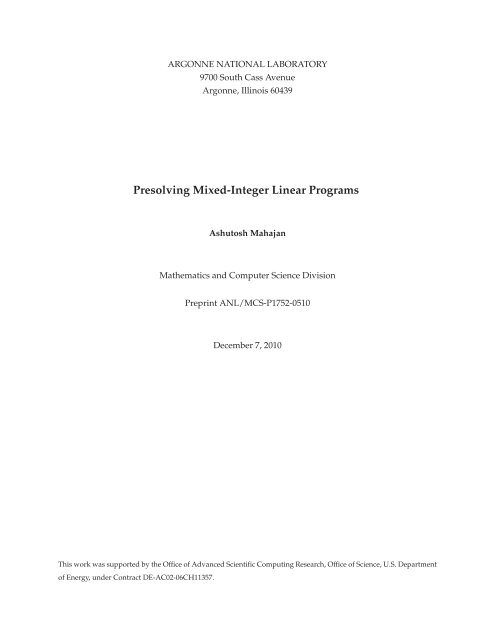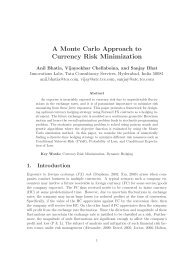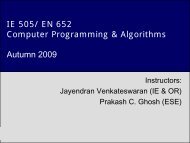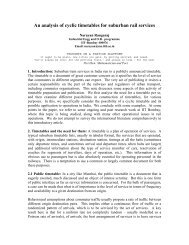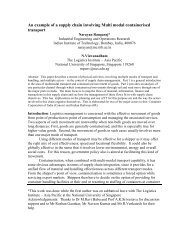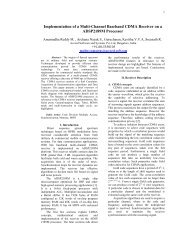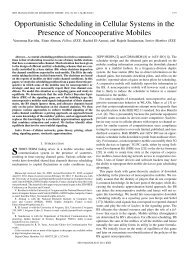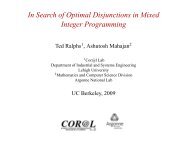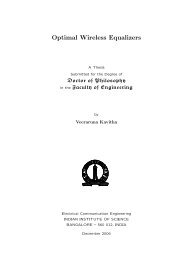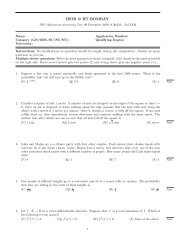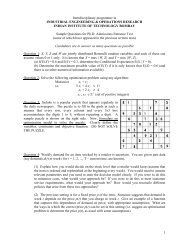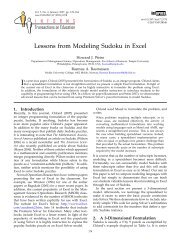Presolving Mixed-Integer Linear Programs - COR@L
Presolving Mixed-Integer Linear Programs - COR@L
Presolving Mixed-Integer Linear Programs - COR@L
Create successful ePaper yourself
Turn your PDF publications into a flip-book with our unique Google optimized e-Paper software.
ARGONNENATIONAL LABORATORY<br />
9700South Cass Avenue<br />
Argonne, Illinois60439<br />
<strong>Presolving</strong> <strong>Mixed</strong>-<strong>Integer</strong><strong>Linear</strong> <strong>Programs</strong><br />
AshutoshMahajan<br />
Mathematics and Computer Science Division<br />
PreprintANL/MCS-P1752-0510<br />
December7,2010<br />
ThisworkwassupportedbytheOfficeofAdvancedScientificComputingResearch,OfficeofScience,U.S.Department<br />
of Energy,under ContractDE-AC02-06CH11357.
Contents<br />
1 Introduction 1<br />
2 Basic <strong>Presolving</strong> 2<br />
2.1 Simple Rearrangements and Substitutions . . . . . . . . . . . . . . . . . . . . . . . . . 2<br />
2.2 Granularity . . . . . . . . . . . . . . . . . . . . . . . . . . . . . . . . . . . . . . . . . . 3<br />
2.3 Constraint and Variable Duplication . . . . . . . . . . . . . . . . . . . . . . . . . . . . 4<br />
2.4 Constraint Domination . . . . . . . . . . . . . . . . . . . . . . . . . . . . . . . . . . . . 4<br />
2.5 BoundImprovement . . . . . . . . . . . . . . . . . . . . . . . . . . . . . . . . . . . . . 5<br />
2.6 Dual/Reduced-CostImprovement . . . . . . . . . . . . . . . . . . . . . . . . . . . . . 6<br />
3 Advanced<strong>Presolving</strong> 7<br />
3.1 Fixing Variables . . . . . . . . . . . . . . . . . . . . . . . . . . . . . . . . . . . . . . . . 7<br />
3.2 Improving Coefficients . . . . . . . . . . . . . . . . . . . . . . . . . . . . . . . . . . . . 7<br />
3.3 DerivingImplications . . . . . . . . . . . . . . . . . . . . . . . . . . . . . . . . . . . . . 8<br />
3.4 Probing on Constraints . . . . . . . . . . . . . . . . . . . . . . . . . . . . . . . . . . . . 10<br />
4 IdentifyingStructure 10<br />
5 Postsolve 11<br />
6 ConcludingRemarks 11<br />
ii
iii
<strong>Presolving</strong><strong>Mixed</strong><strong>Integer</strong><strong>Linear</strong> <strong>Programs</strong> ∗<br />
Ashutosh Mahajan †<br />
December 7,2010<br />
Abstract<br />
Wesurveythetechniquesusedforpresolving<strong>Mixed</strong>-integerlinearprograms(MILPs). <strong>Presolving</strong><br />
is an important component of all modern MILP solvers. It is used for simplifying a<br />
given instance, for detecting any obvious problems or errors, and for identifying structures<br />
and characteristics that are useful forsolving an instance.<br />
Keywords: <strong>Integer</strong> programming, presolving, preprocessing<br />
AMS-MSC2000: 65K05, 90C11<br />
1 Introduction<br />
<strong>Presolving</strong> or preprocessing techniques constitute a broad class of methods used to transform a<br />
given instance of a <strong>Mixed</strong>-integer linear program (MILP) or to collect certain useful information<br />
about it. The main aim of presolving techniques is to simplify the given instance for solving by<br />
the more sophisticated and often time-consuming algorithms such as cutting-plane or branchand-bound<br />
algorithms. Almost all modern solvers, both free (for instance, Achterberg, 2009;<br />
Forrest, 2010; Nemhauser etal., 1994; Ralphs etal., 2010) and commercial (for instance, FICO,<br />
2009; Gurobi, 2009; IBM, 2009), deploy these in one way or the other. Bixby etal. (2000) claim<br />
that presolving alone speeds the solution times on benchmark instances by a factor of 2. Another<br />
importantfunctionofapresolveristoanalyzethestructureoftheinstanceandcollectinformation<br />
that willbe usefulwhenthe problemis solved.<br />
<strong>Presolving</strong> is also useful for the purpose of modeling as it can be used to check the instance<br />
for obvious errors. It can, for instance, inform the user whether certain constraints or bounds<br />
on variables make the instance infeasible or whether certain variables will have arbitrarily high<br />
values (unbounded) in a solution. Such information can help the user improve the description of<br />
the instance and correct errors. It can also sometimes tell the user whether the values used in the<br />
model may cause numerical problems for the subsequent algorithms used by the solver. As such,<br />
∗ PreprintANL/MCS-P1752-0510<br />
† Mathematics and Computer Science Division, Argonne National Laboratory, Argonne, IL 60439,<br />
mahajan@mcs.anl.gov.<br />
1
2 Ashutosh Mahajan<br />
some presolving is also performed by software such as AMPL (Foureretal.,2003) that is used for<br />
creating MILPinstances.<br />
In this survey, we describe the various techniques used for basic and advanced presolving.<br />
Throughoutthe discussion,weassume that the originalMILPis ofthe form<br />
n∑<br />
min c j x j<br />
s.t.<br />
j=1<br />
n∑<br />
a ij x j ≤ b i , i = 1,...,m,<br />
j=1<br />
l j ≤ x j ≤ u j , j = 1,2,...,n,<br />
x j ∈ Z, j ∈ I,<br />
(P)<br />
where m ∈ N,n ∈ N,c ∈ Q n ,A ∈ Q m×n ,l ∈ Q n ,u ∈ Q n ,I ⊆ {1,2,...,n} are given as inputs. We<br />
willexplicitlyclarifywheneveratechniqueappliestoanyequalityconstraints( ∑ n<br />
j=1 a ij = b i )and<br />
nottotheinequalitiesin(P). SometechniquesforpresolvingMILPsarethesameasthoseusedfor<br />
presolvinglinearprograms(LPs). Wealsodescribethesetechniquesherebecausetheyareastarting<br />
point for more advanced techniques for presolving MILPs. Most of the presolving techniques<br />
presented here are derived from the work of Andersenand Andersen (1995), Brearleyand Mitra<br />
(1975), Guignardand Spielberg (1981), and Savelsbergh (1994). Details of implementing the techniquesinanMILPsolvercanbefoundintheworkofSuhl<br />
and Szymanski(1994),andAchterberg<br />
(2007).<br />
We start by describing basic presolving techniques in Section 2 and then describe more advanced<br />
techniques in Section 3. We also discuss methods for detecting structure (Section 4), and<br />
forpostprocessing (Section5).<br />
2 Basic<strong>Presolving</strong><br />
Basic presolving methods are simple procedures that are directly applied to simplify (P). These<br />
methods may be called many times as subroutines in more advanced methods. Hence, implementing<br />
themefficiently isimportant.<br />
2.1 SimpleRearrangementsand Substitutions<br />
Removingconstraintsandvariablesthatarenotnecessaryintheinstancecanreducetheamountof<br />
memoryrequiredbyacomputertosolvetheinstanceandalsospeedthecalculations. Rearranging<br />
theorderofvariablesandconstraintsintheinstancecanspeedseveralroutinesinthesubsequent<br />
preprocessing and solvemethods.<br />
Removing constraints If we have a ij = 0 ∀j ∈ {1,2,...,n} for some i ∈ {1,2,...,m} and if<br />
b i ≥ 0, then the i−th constraint can be deleted. If for the same constraint b i < 0, then the instance
<strong>Presolving</strong><strong>Mixed</strong><strong>Integer</strong> <strong>Linear</strong><strong>Programs</strong> 3<br />
is infeasible because of this constraint. If we have a singleton row, namely, a ik ≠ 0,a ij = 0 ∀j ≠<br />
k,j ∈ {1,2,...,n}, for some i ∈ {1,2,...,m} and some k ∈ {1,2,...,n}, then the ith constraint<br />
can be removed,and the bounds ofvariablex k can be tightenedif necessary.<br />
Removing variables If we have a ij = 0 ∀i ∈ {1,2,...,m} for some j ∈ {1,2,...,n}, then we<br />
can fix the variable x j to l j if c j ≥ 0 or to u j if c j < 0. After fixing the variable, we may have<br />
an additional constant term in the objective function. If we have a singleton column x j , and if<br />
j ∉ I, a ij > 0, l j = −∞, u j = ∞, c j ≤ 0 then we can drop the constraint i and substitute<br />
x j = b i− ∑ k:k≠j a ikx k<br />
a ij<br />
intheobjectivefunction. Afterthesubstitution,wehaveonelessvariableand<br />
one less constraint. The number of nonzeros in A is also reduced. The number of nonzeros in the<br />
objectivefunction,however,may increase.<br />
Rearrangements The variables and constraints of the instance can be rearranged depending on<br />
howthemethodsofsolvingareimplemented. Forexample,itmaybebeneficialtohaveallbinary<br />
variablesstoredintheendofthearrayofvariablessothatdeletingthem(incasewefixthem)from<br />
the sparse representation of the matrix A is faster. Similarly, the constraints can be rearranged so<br />
that “constraints of interest” appear together in the arrays in which they are stored. If it is known<br />
thataninterior-pointmethodwillinitiallybeusedforsolvingtherelaxationof(P),thenrowsand<br />
columns may be rearranged so as to reduce the “fill in”. Rothberg and Hendrickson (1998) study<br />
the effectsof varioussuchpermutation techniqueson interior-pointmethods.<br />
2.2 Granularity<br />
Givenan instance ofform(P) and avector a ∈ Q n ,wedefine granularityof aas<br />
g(a) = min<br />
x 1 ,x 2 ∈P<br />
⎧<br />
⎨<br />
n∑<br />
⎩<br />
a ij x 1 j −<br />
∣<br />
j=1<br />
n∑<br />
a ij x 2 n∑<br />
j<br />
∣ : a ij x 1 j ≠<br />
j=1<br />
j=1<br />
⎫<br />
n∑ ⎬<br />
a ij x 2 j<br />
⎭ ,<br />
whereP isthesetofallpointssatisfyingtheconstraintsof(P). Granularityreferstotheminimum<br />
difference (greater than zero) between the values of activity that a constraint or objective function<br />
may have at two different feasible points. For a constraint that has only integer-constrained<br />
variables, then granularity is at least the greatest common divisor (GCD) of all the coefficients. If<br />
any of the coefficients in such a constraint are not integers, we can find a multiplier 10 K , where<br />
K ∈ Z + , to make all coefficients integers. The GCD can be divided by 10 K to get granularity.<br />
Hoffman and Padberg (1991) call this procedure Eucledean reduction. The problem can be declaredinfeasibleifthereisanequalityconstraintwhoseright-hand<br />
sideisnotanintegermultiple<br />
of the of the GCD. For an inequality constraint i ∈ {1,2,...,m}, if b i is not an integer multiple<br />
of the granularity g(a i ), then b i can be reduced to the nearest multiple of g i less than b i . So the<br />
constraint<br />
3x 1 +6x 2 −3x 3 ≤ 5.3<br />
j=1
4 Ashutosh Mahajan<br />
can be tightenedto<br />
3x 1 +6x 2 −3x 3 ≤ 3,<br />
ifx 1 ,x 2 ,x 3 ∈ Z. TheboundtighteninginthiscaseisaspecialcaseofaChvátal-Gomoryinequality<br />
introduced by Gomory (1958). Similarly, one can find the granularity of the objective vector c<br />
when only integer-constrained variables have nonzero coefficients in the objective function. The<br />
differencebetweenupperboundobtainedfromafeasiblesolutionandtheoptimalsolutionvalue<br />
will always be at least g(c). If the difference between an upper bound and a lower bound falls<br />
below the granularity, we can stop the branch-and-bound or cutting-plane algorithm and claim<br />
that the optimal solutionhas beenfound.<br />
2.3 Constraintand Variable Duplication<br />
Sometimesaninstancemayhaveduplicateconstraintsthatareexactcopiesofeachother. Atother<br />
times,wemayhaveconstraintsthatareidenticalexceptforascalarmultiple. Theobviousbenefit<br />
ofdetectingsuchconstraintsisthatwecanreducethememoryneededforstoringandsolvingthe<br />
instance. ItalsohelpsimprovethenumericalstabilityofsolutionoftheassociatedLPrelaxations.<br />
Bixby and Wagner (1987), and Tomlinand Welch (1986) describe efficient ways to detect from a<br />
column-ordered format of A, whether two constraints are identical except for scalar multiples.<br />
When constraints with duplicate entries are found, we can, based on the values of the right hand<br />
sides and the scalar multiples, declare the problem infeasible or delete one of the constraints or<br />
combine the twoconstraints into one.<br />
Similarly,wecan detectwhether twocolumns arealikeexcept forascalarmultiple. However,<br />
the possible integrality constraint on one or both of these variables can make any substitution<br />
complicated. If A j = αA i and if c j = αc i for some i,j ∈ {1,2,...,n} \ I,α ∈ Q, then we can<br />
replacethetwocolumnsA i ,A j byasinglecolumnA k thatisidenticaltoA i . Thelowerandupper<br />
bounds of the new variable x k are l k = l i + αl j ,u k = u i + αu j if α > 0 and l k = l i + αu j ,u k =<br />
u i + αl j otherwise. If one or both variables are integer constrained, we can use the substitution<br />
x k = x i + αx j if we can find feasible values of x i ,x j for each x k ∈ [l k ,u k ]. We can also add a<br />
constraint x k = x i +αx j to avoidsuchcomplications.<br />
2.4 ConstraintDomination<br />
One way to identify a redundant constraint is to check whether it can be termwise dominated<br />
by another constraint. If b k ≥ b i for i,k ∈ {1,2,...,m}, each variable in constraints i,k is either<br />
non-negative or non-positive, a kj ≤ a ij for j such that x j is non-negative and a kj ≥ a ij for j such<br />
that x j is non-positive, then constraint k can be deleted because it is redundant in the presence of<br />
constraint i and the bounds onvariables.
<strong>Presolving</strong><strong>Mixed</strong><strong>Integer</strong> <strong>Linear</strong><strong>Programs</strong> 5<br />
2.5 BoundImprovement<br />
Bound improvement is one of the most important steps of presolving. If we can improve the<br />
boundsonvariablesorreduceb i ,thenwecantightentheLPrelaxationof(P). Thetightestbounds<br />
onaconstraint can be obtained(Savelsbergh,1994) by solvingthe followingproblems,<br />
n∑<br />
L i = min a T i x<br />
j=1<br />
s.t. A i x ≤ b i , (2.1)<br />
l j ≤ x j ≤ u j , j = 1,2,...,n<br />
x j ∈ Z, j ∈ I,<br />
and<br />
n∑<br />
U i = max a T i x<br />
j=1<br />
s.t. A i x ≤ b i , (2.2)<br />
l j ≤ x j ≤ u j , j = 1,2,...,n<br />
x j ∈ Z, j ∈ I,<br />
where the set of constraints A i x ≤ b i is obtained by deleting the ith constraint ∑ n<br />
j=1 a ijx j ≤ b i<br />
from (P). However, solving the bound improvement problems (2.1) or (2.2) can be as difficult as<br />
solving (P). Thus, there is a trade-off between the quality of a good bound and the time spent in<br />
findingit. ThemostcommonmethodoftighteningtheboundistocalculateboundsonL i andU i :<br />
ˆL i = ∑<br />
a ij l j + ∑<br />
a ij u j ,<br />
j:a ij >0<br />
Û i = ∑<br />
j:a ij >0<br />
j:a ij
6 Ashutosh Mahajan<br />
and<br />
U k = maxx k<br />
s.t. Ax ≤ b, (2.5)<br />
l j ≤ x j ≤ u j , j = 1,2,...,n<br />
x j ∈ Z, j ∈ I.<br />
Again,solvingtheproblems(2.4)and(2.5)canbeasdifficultastheoriginalproblem(P). Asimilar<br />
trade-off then occurs on the quality of the bound and the time spent in obtaining it. The bounds<br />
L i and U i onconstraints can alsobe usedto improve the bounds on variables. If a ij > 0,thenlet<br />
Û ik = b i<br />
a ik<br />
− L i −a ik l k<br />
a ik<br />
.<br />
Clearly, Ûik (≥ U k ) is an upper bound on the feasible values of x k . If U k < u k (or Ûk < u k ), then<br />
update the bound on variable x k to U k . If U k < l k , then the problem is infeasible. If U k = l k , then<br />
the variablex k can be fixed to the valuel k . Similarly,ifa ik < 0, thenlet<br />
ˆL ik = b i<br />
a ik<br />
− U i −a ik l k<br />
a ik<br />
.<br />
Then ˆL ik (≤ L k ) is also a lower bound on feasible values of x k . If L k < l k , then update the lower<br />
bound on variable x k to L ik . If L ik > u k , then the problem is infeasible. If L ik = u k , then the<br />
variable x k can be fixed to the value u k . Once L i and U i (or their bounds ˆL i ,Ûi) are known, then<br />
the bounds ˆL,Û canbe calculatedin O(nz) steps.<br />
Iftheboundsaretightenedusingthecompletemodels(2.1)and(2.2),thenconstraintdomination<br />
is just a special case of bound tightening. This is no longer true, however, when the bounds<br />
areestimatedfromeachrow. Inthelattercase,weneedonlyO(nz)calculations,wherenz denotes<br />
the number ofnonzeros inthe Amatrix.<br />
If the bounds of a variable x j are implied by a constraint, then the variable can be declared<br />
“free”,and we cantry substituting the variableoutas describedinSection2.1.<br />
2.6 Dual/Reduced-CostImprovement<br />
If,foravariablex j ,j ∈ {1,2,...,n},a ij ≥ 0 ∀i ∈ {1,2,...,m},andc j ≥ 0,thenthevariablex j can<br />
be fixed to its lower bound l j . Similarly, if a ij ≤ 0 ∀i ∈ {1,2,...,m} and c j ≤ 0, then the variable<br />
x j canbe fixed to its upper bound u j .<br />
Sometimes, an upper bound on the optimal value of solution of (P) is known (it may be provided<br />
by the user or may be obtained from some heuristics) before presolving. In such a case,<br />
we have an additional inequality ∑ n<br />
j=1 c jx j ≤ z u , where z u is the best-known upper bound. The<br />
basic presolving techniques applicable to other constraints can be applied to this constraint as<br />
well. Valid inequalities of the form ∑ n<br />
j=1ĉjx j ≥ z l , where z l ∈ Q, can also be obtained by linear<br />
combinations of the objective function with other constraints. Such inequalities are automatically
<strong>Presolving</strong><strong>Mixed</strong><strong>Integer</strong> <strong>Linear</strong><strong>Programs</strong> 7<br />
obtainedfromthereducedcostscalculatedbythesimplexmethod. Whenbothz l andz u areavailable<br />
as described above, we can do bound tightening on variables to obtain tighter bounds. This<br />
is equivalentto the reduced-costfixing method describedbyBalas and Martin(1980).<br />
3 Advanced <strong>Presolving</strong><br />
Advanced presolving procedures try to modify the problem and then call basic preprocessing<br />
procedures repeatedly to derive more information about the effects of such changes. Such procedures<br />
are also called probing. Unlike basic preprocessing techniques, probing may be expensive<br />
becauseonecanprobeonmanypossiblechangesoroncombinationsofseveralchanges. Thesimplest<br />
changes are the changes of bounds on binary variables. We can fix such a variable to zero or<br />
1and then probe onthe reducedproblem.<br />
3.1 FixingVariables<br />
When probing on a binary variable, say x i , we first fix x i to zero by changing its upper bound.<br />
We then perform basic preprocessing on the modified problem. If the modified problem can be<br />
showntobeinfeasible,thenx i canbefixedtooneintheoriginalproblem. Similarly,iftheproblem<br />
becomesinfeasibleonsettingx i toone,wecanfixx i tozero. Iftheproblemisinfeasibleonsetting<br />
x i to one and zero both, wecan declarethatthe problemis infeasible.<br />
3.2 ImprovingCoefficients<br />
Ifaconstrainti, ∑ n<br />
j=1 a ijx j ≤ b i isredundantwhenabinaryvariablex k issettozero,thenwecan<br />
improvethecoefficienta ik ofx k inthisconstraintusingtheapproachofCrowderetal.(1983). We<br />
firstobservethatchanginga ik doesnotmakeanydifferencewhenx k = 0. Whenx k issetto1,the<br />
original constraint is equivalent to ∑ n<br />
j=1 a ijx j −δ 0 x k ≤ b i −δ 0 , for any δ 0 ∈ R. We would like to<br />
have as high a value of δ 0 as possible, while still keeping the constraint redundant at x k = 0. This<br />
valueof δ 0 can be obtainedby solvingthe followingproblem:<br />
where Qis the setofvaluesof x suchthat<br />
δ 0 = b i −max<br />
Q<br />
n∑<br />
a ij x j ,<br />
j=1<br />
A i x ≤ b i ,<br />
x k = 0,<br />
l j ≤ x j ≤ u j , j = 1,2,...,n<br />
x j ∈ Z, j ∈ I.
8 Ashutosh Mahajan<br />
Again, the problem of finding the optimal value of δ 0 can be as hard as solving the original problem(P).<br />
Amore easilycomputable bound,<br />
∑<br />
ˆδ 0 = b i −<br />
j:j≠k,a ij >0<br />
a ij u j −<br />
∑<br />
j:j≠k,a ij 0<br />
j:j≠k,a ij
<strong>Presolving</strong><strong>Mixed</strong><strong>Integer</strong> <strong>Linear</strong><strong>Programs</strong> 9<br />
Deriving such implications is useful not only for preprocessing but also for other techniques<br />
suchasprimalheuristics,branching,andgeneratingvalidinequalities,thataresubsequentlyused<br />
in solving (P). The number of such implications can, however, be very large for certain types of<br />
problems. Forexample, ifwe have asetpartitioning constraintof the form<br />
∑<br />
x i = 1,<br />
i∈S<br />
wherex i isbinaryfori ∈ S,thenthenumberofvalidimplicationswithonlytwovariableswould<br />
beO(|S| 2 ). Thusitisimportanttoimplementmethodstostoreandretrievethemquickly. Several<br />
implications can also be combined to fix variables, to delete constraints, and to derive new implications,<br />
e.g., if we have implications x 1 = 0 ⇒ x 2 = 0, and x 1 = 1 ⇒ x 2 = 0, then we can fix<br />
x 2 at 0. Similarly, if a constraint is redundant when x 1 = 0 and also when x 1 = 1, then we can<br />
delete that constraint. The algorithms for deriving such new information from an existing list of<br />
implications can be studiedwith the helpof whatis calledaconflictgraph.<br />
A conflict graph is a graph that shows what values of binary variables<br />
are not feasible (or optimal) for (P). The graph has two sets X, ¯X<br />
of k vertices each, where k is the number of binary variables. For each<br />
binary variable x i in (P), we have a vertex each in X (denoted i), and in<br />
¯X (denoted ī). A vertex i ∈ X corresponding to variable x i is associated<br />
withtheimplication“x i = 1”. Similarly,avertexi ∈ ¯X isassociatedwith<br />
“x i = 0”. An edge between two vertices denotes a conflict, i.e., any optimal<br />
solution of (P) can not have values associated with the two vertices<br />
ofanyedgeintheconflictgraph. Figure1showsaconflictgraphinthree<br />
variables. Three implications that create the edges are x 1 = 1 ⇒ x 2 = 1,<br />
x 3 = 1 ⇒ x 2 = 1, and x 3 = 1 ⇒ x 1 = 0. The dark edges in the graph denotethateitherx<br />
i = 1orx i = 0,andoneofthemnecessarilyholds. New<br />
implicationscannowbederivedbystudyingthisgraph,e.g.,ifthereisa<br />
vertexj withneighborsi,ī,thenx j canbefixedto0. Wereferthereaders<br />
to the work of Savelsbergh (1994), and Atamtürk and Savelsbergh (2000)<br />
1<br />
2<br />
3<br />
Figure 1: An example<br />
ofaconflict graph<br />
foralgorithmsthatcanbeusedtoderivesuchimplications. Thelatteralsodescribedatastructures<br />
for storing them efficiently. We now mention two more ways in which implications are useful for<br />
improving aformulation.<br />
¯1<br />
¯2<br />
¯3<br />
Automatic disaggregation: Savelsbergh (1994) shows that, if we add the inequalities derived<br />
fromimplications as above,thenwe automatically disaggregateeachconstraint ofthe form<br />
∑<br />
x i ≤ Ux k ,<br />
where S ⊆ {1,2,...,n},k ∈ {1,2,...,n},and U ≤ ∑ i∈S u i,into the inequalities<br />
x i ≤ u i x k ,i ∈ S.<br />
i∈S
10 Ashutosh Mahajan<br />
Elimination of variables: If fixing a binary variable x k to zero implies x i = r i for some i ∈<br />
{1,2,...,n}and fixing x k to one impliesx i = s i forsome r i ,s i ∈ R, thenwe can substitute<br />
x i = r i +(s i −r i )x k .<br />
Thevariablex i cannowbeeliminatedfromtheproblemwithoutincreasingthenumberofnonzeros<br />
inthe Amatrix.<br />
3.4 ProbingonConstraints<br />
Consideracliqueinequalityof the form<br />
∑<br />
x i − ∑<br />
i∈S +<br />
i∈S − x i ≤ 1− ∣ ∣S −∣ ∣,<br />
whereS + ,S − ⊆ {1,2,...,n},andallx i arebinaryfori ∈ S + ∪S − . Thetuple{x i },i ∈ S + ∪S − can<br />
assumeonly|S + ∪S − |+1valuesforanyfeasiblepoint. Outofthese,|S + ∪S − |valuescorrespond<br />
to exactly one of x i ,i ∈ S + being 1 or exactly one of x i ,i ∈ S − being zero. All these cases are<br />
therefore considered automatically when probing on these variables. The only remaining case<br />
that is feasible for this constraint is when x i = 0,∀i ∈ S + and x i = 1,∀i ∈ S − . If the problem is<br />
infeasibleforthiscase,thentheinequalitycanbetightenedtoanequality. Ifsomeotherinequality<br />
is redundant,then the coefficients can be tightenedfollowingthe procedurein Section3.2.<br />
4 IdentifyingStructure<br />
Manytechniquesforgeneratingvalidinequalities,branchingandheuristicsareapplicableonlyfor<br />
particular types of constraints and variables. Yet others may be greatly improved if some special<br />
structuresareknowntoexist. Sincesuchtechniquesareusedrepeatedlymanytimesinthebranchand-boundorcutting-planemethods,itisimportanttodetectupfrontanyusefulstructuresinthe<br />
givenMILP.Some of thesestructures are listedbelow.<br />
• Special orderedsetsof type 1(SOS1) areof the form<br />
∑<br />
x i = 1,<br />
x k = ∑ a i x i ,<br />
i∈S<br />
x i ∈ {0,1},i ∈ S ⊆ {1,2,...,n}.<br />
These can be usedforspecial branching rules(Bealeand Tomlin,1970).<br />
• Set partitioning ( ∑ i∈S x i = α,x i ∈ {0,1},i ∈ S), set covering ( ∑ i∈S<br />
≥ α), and set packing<br />
inequalities ( ∑ i∈S x i ≤ α) can be used for primal heuristics (Atamtürk etal., 1995) and for<br />
generating validinequalities(Balasand Padberg,1976).<br />
i∈S
<strong>Presolving</strong><strong>Mixed</strong><strong>Integer</strong> <strong>Linear</strong><strong>Programs</strong> 11<br />
• Knapsack inequalities including 0-1 knapsack, mixed 0-1 knapsack, integer knapsack, and<br />
mixed-integerknapsack inequalities(Atamtürk,2005).<br />
• Generalized upper bound constraints can be used to generate valid inequalities (Wolsey,<br />
1990).<br />
• Variable lower bound and upper bound constraints can also be used to generate valid inequalities(vanRoy<br />
and Wolsey,1987).<br />
5 Postsolve<br />
After an instance has been treated by a presolver and then solved, the user may ask for the solution<br />
and other problem characteristics. The presolvercan change some instance substantially and<br />
the solution of the transformed problem may be quite different from that of the original problem.<br />
Hence the presolve routines are designed to save the changes that were made to the original instance.<br />
Andersenand Andersen (1995) suggest keeping a “stack” of all the transformations that<br />
were made by the presolver and reverting them in a last-in-first-out sequence. Sometimes, the<br />
solutionobtainedbyrevertingthechangesmaynotremainfeasibleforthespecifiedtolerancevalues<br />
even though the presolved solution was feasible. In such cases, the user must either decrease<br />
the tolerance limitor disablepresolve.<br />
6 ConcludingRemarks<br />
In this paper, we have surveyed many techniques for presolving. Some of these techniques are<br />
simple, like removing empty constraints, and empty columns, identifying special structures and<br />
rearranging constraints and variables. Some others are more powerful, like detecting duplicate<br />
rows and columns. They require specialized algorithms to avoid spending excessive amount of<br />
time. Then there are some methods like bound tightening, detecting infeasibility and identifying<br />
redundant constraints which in theory can be as difficult as solving the original problem itself.<br />
Heuristic methods are used to trade off the time spent in these problems against the benefits<br />
of solving them. All of these methods usually consider only bounds on variables and a single<br />
constraint. Advancedpresolvingmethodscanhelpsimplifyingtheproblemsalotbuteachprobe<br />
requires repeating basic presolving methods. Further, one needs to probe over many candidate<br />
variables. Ingeneral,itisdifficulttopredicttheoptimaleffortthatshouldbeputintoeachmethod<br />
of presolving. Most implementations of a presolver rely on several rules of thumb and the past<br />
experienceswith thesemethods.<br />
A presolver is an important component of modern MILP solvers. It can substantially reduce<br />
the time taken to solve MILPs. It is also useful for conveying to the user obvious problems with<br />
the formulation of the instance. However, the percentage of time spent by a solver in presolve<br />
routinesisusuallymuchsmallerthanthepercentageoflinesofcoderequiredtowriteapresolver.
12 Ashutosh Mahajan<br />
Even though the techniques of presolving are simple, implementing them effectively for all types<br />
offormulations and inputs canbe achallenging activity.<br />
Acknowledgments<br />
The author gratefully acknowledges the anonymous referee for suggestions and recommendations<br />
that helped improve this survey, and also Gail Pieper for proofreading an earlier draft. This<br />
work was supported by the Office of Advanced Scientific Computing Research, Office of Science,<br />
U.S. Department of Energy, under Contract DE-AC02-06CH11357. This work was also supported<br />
by the U.S. Department ofEnergy throughgrant DE-FG02-05ER25694.<br />
References<br />
Achterberg,T.(2007). Constraintintegerprogramming. PhD thesis,Technical UniversityofBerlin.<br />
Achterberg, T. (2009). SCIP: solving constraint integer programs. Mathematical Programming Computation,1(1):1–49.<br />
Andersen, E. and Andersen, K. (1995). <strong>Presolving</strong> in linear programming. Mathematical Programming,71:221–245.<br />
Atamtürk, A. (2005). Cover and pack inequalities for (mixed) integer programming. Annals of<br />
OperationsResearch,139(1):21–38.<br />
Atamtürk, A., Nemhauser, G. L., and Savelsbergh, M. W. P. (1995). A combined Lagrangian,<br />
linear programming and implication heuristic for large-scale set partitioning problems. Journal<br />
ofHeuristics,1:247–259.<br />
Atamtürk, A. and Savelsbergh, M. W. P. (2000). Conflict graphs in solving integer programming<br />
problems. EuropeanJournalofOperationalResearch,121:40–55.<br />
Balas,E.andMartin,C.(1980). Pivotandcomplement-aheuristicfor0-1programming. ManagementScience,26(1):86–96.<br />
Balas,E.and Padberg,M.W.(1976). Setpartitioning: Asurvey. SIAMReview,18(3):710–760.<br />
Beale, E. M. L. and Tomlin, J. A. (1970). Special facilities in general mathematical programming<br />
system for non-convex problems using ordered sets of variables. In Lawrence, J., editor, ProceedingsoftheFifthInternationalConferenceon<br />
OperationsResearch,pages 447–454.<br />
Bixby, R. E., Fenelon, M., Gu, Z., Rothberg, E., and Wunderling, R. (2000). MIP: Theory and<br />
practice - closing the gap. In Powell, M. J. D. and Scholtes, S., editors, System Modelling and<br />
Optimization: Methods,Theory,andApplications,pages 19–49.KluwerAcademicPublishers.
<strong>Presolving</strong><strong>Mixed</strong><strong>Integer</strong> <strong>Linear</strong><strong>Programs</strong> 13<br />
Bixby, R. E. and Wagner, D. (1987). A note on detecting simple redundancies in linear systems.<br />
OperationsResearchLetters,6(1):15–17.<br />
Brearley, A. and Mitra, G. (1975). Analysis of mathematical programming problems prior to applying<br />
the Simplexalgorithm. MathematicalProgramming,8:54–83.<br />
Crowder,H., Johnson, E.L., and Padberg,M. (1983). Solving large scale zero-one linear programming<br />
problems. OperationsResearch,31(4):803–834.<br />
FICO (2009). Xpress-Moseluserguide. Available online at http://optimization.fico.com.<br />
Forrest, J. (2010). COIN-OR Branch and Cut. Available online at<br />
https://projects.coin-or.org/Cbc.<br />
Fourer, R., Gay, D., and Kernighan, B. (2003). AMPL: A Modelling Language for Mathematical Programming.<br />
Brooks/ColePublishing Company, PacificGrove,CA.<br />
Gomory, R. E. (1958). Outline of an algorithm for integer solutions to linear programs. Bulletin of<br />
American MathematicalSociety,64:275–278.<br />
Guignard, M. and Spielberg, K. (1981). Logical reduction methods in zero-one programming:<br />
minimal preferredvariables. OperationsResearch,29(1):49–74.<br />
Gurobi (2009). Gurobi optimizerreferencemanual. Availableonline at http://www.gurobi.com.<br />
Hoffman, K. and Padberg, M. (1991). Improving LP-representations of zero-one linear programs<br />
forbranch-and-cut. ORSAJournalon Computing,3(2):121–134.<br />
IBM (2009). User’s manual for CPLEX V12.1. Available online at<br />
http://ibm.com/software/integration/optimization/cplex/.<br />
Nemhauser,G.,Savelsbergh,M.,andSigismondi,G.(1994). MINTO,a<strong>Mixed</strong>INTegerOptimizer.<br />
OperationsResearchLetters,15(1):47–58.<br />
Ralphs, T., Guzelsoy, M., and Mahajan, A. (2010). SYMPHONY 5.2.3 user’s manual. Available<br />
online at https://projects.coin-or.org/SYMPHONY.<br />
Rothberg,E.andHendrickson,B.(1998). Sparsematrixorderingmethodsforinteriorpointlinear<br />
programming. InformsJournalon Computing, 10(1):107–113.<br />
Savelsbergh, M. W. P. (1994). Preprocessing and probing techniques for mixed integer programming<br />
problems. ORSA Journalon Computing,6:445–454.<br />
Suhl, U. H. and Szymanski, R. (1994). Supernode processing of mixed-integer models. Computationaloptimization<br />
andapplications,3:317–331.<br />
Tomlin,J.andWelch,J.(1986). Findingduplicaterowsinalinearprogrammingmodel. Operations<br />
ResearchLetters,5(1):7–11.
14 Ashutosh Mahajan<br />
van Roy, T. J. and Wolsey, L. A. (1987). Solving mixed integer programming problems using<br />
automaticreformulation. OperationsResearch,35(1):45–57.<br />
Wolsey,L.A.(1990). Validinequalitiesfor0-1knapsacksandMIPswithgeneralizedupperbound<br />
constraints. DiscreteAppliedMathematics,29:251–261.<br />
The submitted manuscript has been created by the UChicago Argonne, LLC, Operator of Argonne National Laboratory (“Argonne”)<br />
under Contract No. DE-AC02-06CH11357 with the U.S. Department of Energy. The U.S. Government retains for itself, and others<br />
acting on its behalf, a paid-up, nonexclusive, irrevocable worldwide license in said article to reproduce, prepare derivative works,<br />
distributecopiesto the public,and performpubliclyand display publicly,byoronbehalfofthe Government.


